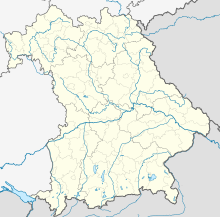Lion wall
Coordinates: 48 ° 35 ′ 55.1 ″ N , 13 ° 19 ′ 21.5 ″ E
The Löwenwand is a rocky steep slope facing the Danube in the northwest of Passau in the Heining district .
Surname
A lion on a monument to King Maximilian I of Bavaria ( Lion Monument, also Lion of Schalding ) serves as the name giver for the wall . The base bears the following inscription: " Maximilian I, Koenig der Baiern, opened this safe path to public traffic over rocks that no hiker had ever stepped on. To the monument of his care for the inhabitants of the Unterdonau district, in 1823. " With "Bahn “This does not mean the railway , which was only built between 1856 and 1859, but the Neue Poststrasse from Vilshofen , as it is marked on the old land map .
On older maps of the lion wall is only the generic name used in other places on the site Danube conduct . The north-western part of the Neuburg Forest in this area was formerly called the Seestetter Forest (after the village of Seestetten, which, however, is about two hundred meters further up the Danube and already belongs to the town of Vilshofen).
geography
The rock wall forms the northern boundary of the Neuburg Forest . It extends over a length of four kilometers, from river kilometer 2239.9 to 2235.8. The western boundary is the Laufenbach, which flows directly from Seestetten (part of the town of Vilshofen ) into the Danube, where the westernmost part of Heining named after the stream is located at the foot of the wall. The wall extends along the Danube to the east, not quite as far as the Bibersbach in the Heiningen district of Wörth on the right of the Danube . The Lion Monument is located there at river kilometer 2235.8 on the Danube side of federal road 8. The Löwenwand rises steeply from the foot near the bank of the Danube, from a good 300 to over 350 meters with a gradient of sometimes over 45 degrees. Then the slope flattens out, but peaks at heights over 400 meters above sea level, for example Roßdobel.
Opposite the Löwenwand is the village of Gaishofen, district Otterskirchen , municipality Windorf, on the left, northern bank of the Danube . Above it, opposite Seestetten, is the left side of the Danube , which is now known as this .
The Danube forms an antecedent breakthrough valley here. The Neuburg Forest represents the foothills of the Moldanubic that runs south of the Danube .
traffic
At the foot of the wall on the right bank of the Danube, federal road 8 and the Regensburg – Passau railway line run right next to each other in a very confined space (sometimes only 20 meters from the bank of the Danube to the foot of the Lion Wall).
The double-track railway line, which runs a little higher at the foot of the Löwenwand, and the main road next to the Danube share the narrow strip that has emerged between the Danube and the Löwenwand.
Because of this lack of space, expansion of the traffic routes is hardly possible. The main road here is significantly narrower and more curvy than the expanded sections before and after the Löwenwand. Due to the increased risk of accidents as a result of this, the speed limit is limited to 80 km / h and overtaking is prohibited.
The railway line can only be traveled here at a maximum speed of 80 km / h. Only ICE trains with tilting technology are allowed to travel this section of the route at speeds of up to 120 km / h.
The Löwenwand can be accessed through various hiking trails and climbs, for example through the Soldiersbrunnweg, which leads from the Laufenbach district into the wall, as well as from the Jägerweg, Leitenwiesweg and Tiefenbachweg.
swell
- ^ Julius Michaelis: Germany's railways. A handbook for business people, capitalists and speculators, containing the history and description of the railways, their constitution, investment capital, frequency, income, profitability and reserve funds, together with a tabular overview of the share prices. CF Amelang's Verlag, Leipzig 1859.
- ↑ BayernAtlas, Historical Maps
- ↑ Excerpt from original position sheet 539 “Unterhasselbach” from 1863 ( page no longer available , search in web archives ) Info: The link was automatically marked as defective. Please check the link according to the instructions and then remove this notice. .
- ↑ The name Donauleite is used today for the steep slope on the left, northern bank of the Danube opposite Seestetten, i.e. above the bank of the Danube directly opposite the Löwenwand : Bayernviewer
- ↑ Donauleiten is also the name of the entire canyon slopes of the Danube between Passau and the Eferdinger basin, in the German nature reserve Donauleiten and the whole of Upper Austria's Upper Danube Valley .




